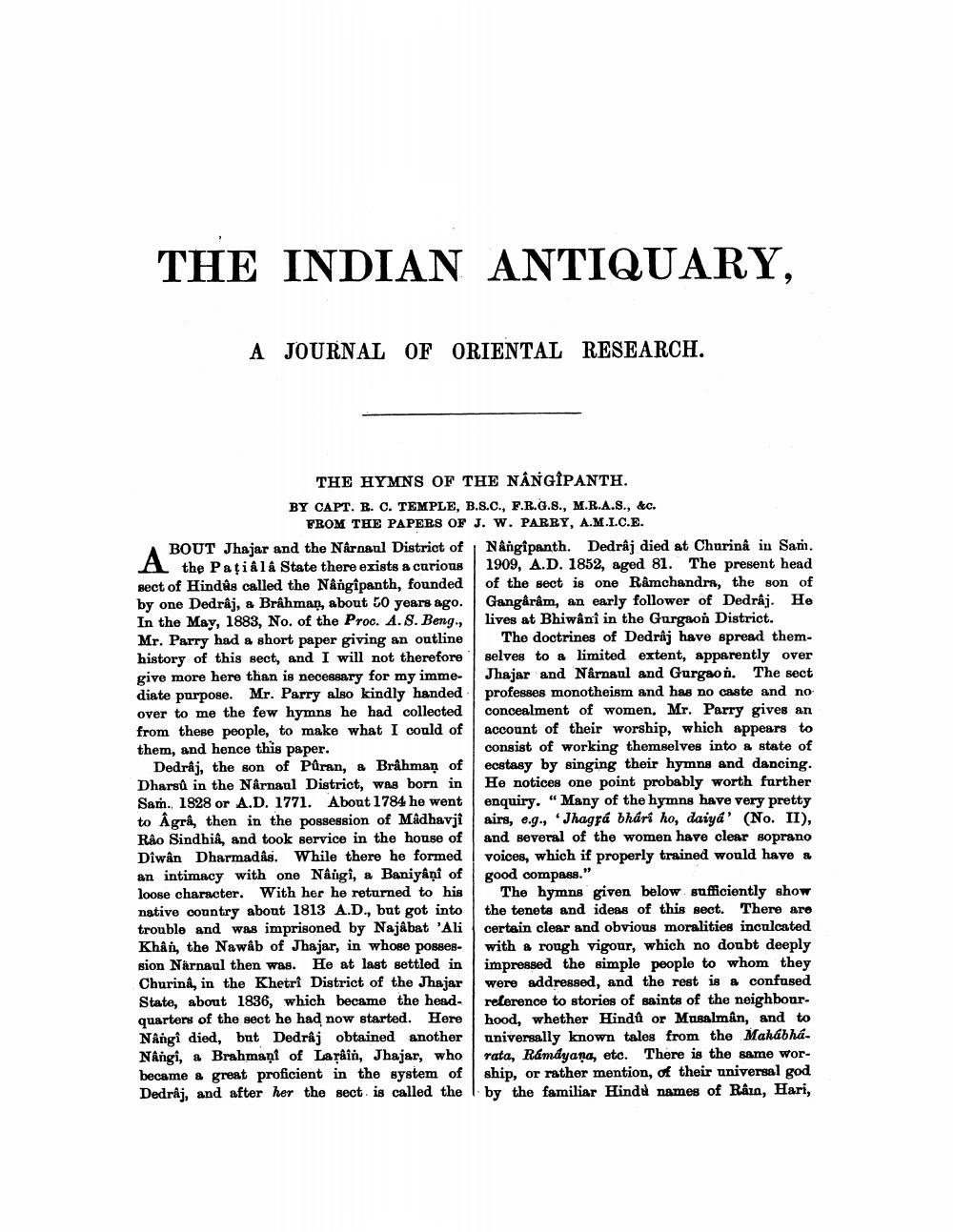Book Title: Indian Antiquary Vol 13 Author(s): John Faithfull Fleet, Richard Carnac Temple Publisher: Swati Publications View full book textPage 7
________________ THE INDIAN ANTIQUARY, A JOURNAL OF ORIENTAL RESEARCH. THE HYMNS OF THE NANGIPANTH. BY CAPT. B. C. TEMPLE, B.S.C., F.R.G.S., M.R.A.S., &c. FROM THE PAPERS OF J. W. PARRY, A.M.I.C.E. BOUT Jhajar and the Nârnaul District of A the State there exists a curious sect of Hindâs called the Nângîpanth, founded by one Dedrâj, a Brahman, about 50 years ago. In the May, 1883, No. of the Proc. A. S. Beng., Mr. Parry had a short paper giving an outline history of this sect, and I will not therefore give more here than is necessary for my immediate purpose. Mr. Parry also kindly handed over to me the few hymns he had collected from these people, to make what I could of them, and hence this paper. Dedraj, the son of Pûran, a Brahman of Dharsû in the Nârnaul District, was born in Sam. 1828 or A.D. 1771. About 1784 he went to Agrâ, then in the possession of Mâdhavji Rao Sindhiâ, and took service in the house of Dîwân Dharmadâs. While there he formed an intimacy with one Nâigi, a Baniyânî of loose character. With her he returned to his native country about 1813 A.D., but got into trouble and was imprisoned by Najâbat 'Ali Khân, the Nawab of Jhajar, in whose possession Narnaul then was. He at last settled in Churina, in the Khetri District of the Jhajar State, about 1836, which became the headquarters of the sect he had now started. Here Nângi died, but Dedrâj obtained another Nângi, a Brahmant of Larâin, Jhajar, who became a great proficient in the system of Dedraj, and after her the sect is called the Nângîpanth. Dedrâj died at Churinâ in Sam. 1909, A.D. 1852, aged 81. The present head of the sect is one Ramchandra, the son of Gangårâm, an early follower of Dedrâj. He lives at Bhiwânî in the Gurgaon District. The doctrines of Dedrâj have spread themselves to a limited extent, apparently over Jhajar and Narnaul and Gurgaon. The sect professes monotheism and has no caste and noconcealment of women. Mr. Parry gives an account of their worship, which appears to consist of working themselves into a state of ecstasy by singing their hymns and dancing. He notices one point probably worth further enquiry. "Many of the hymns have very pretty airs, e.g., Jhagrá bhári ho, daiya' (No. II), and several of the women have clear soprano voices, which if properly trained would have a good compass." The hymns given below sufficiently show the tenets and ideas of this sect. There are certain clear and obvious moralities inculcated with a rough vigour, which no doubt deeply impressed the simple people to whom they were addressed, and the rest is a confused reference to stories of saints of the neighbourhood, whether Hindû or Musalman, and to universally known tales from the Mahábhárata, Rámáyana, etc. There is the same worship, or rather mention, of their universal god by the familiar Hindu names of Rân, Hari,Page Navigation
1 ... 5 6 7 8 9 10 11 12 13 14 15 16 17 18 19 20 21 22 23 24 25 26 27 28 29 30 31 32 33 34 35 36 37 38 39 40 41 42 43 44 45 46 47 48 49 50 51 52 53 54 55 56 57 58 59 60 61 62 63 64 65 66 67 68 69 70 71 72 ... 492
